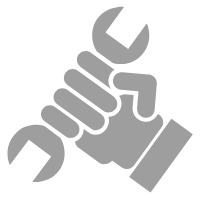Many base model work trucks forego locking 4WD systems or complex AWD systems in favor of the simplicity (and lower cost) of driving only two wheels. Manufacturers typically use a rear-wheel drive configuration for these vehicles since RWD offers much better control and safety when the bed is empty. Of course, this configuration means these trucks rely on a driveshaft for power transmission.
In a perfect world, these simple and easy-to-maintain models wouldn't need complex driveshafts, but nothing is ever quite so easy. Even the most utilitarian truck will require a driveshaft that can transmit power while flexing and moving with the suspension. Since these driveshaft designs require numerous individual components, it's important to learn the warning signs of these three potential failures.
1. Center Bearing Failure
The center bearing (also known as the center support bearing or CSB) is effectively a mounting point for your driveshaft. Since the driveshaft must be able to rotate freely while also moving slightly with the truck's suspension, it's impossible to mount it directly to the chassis. Instead, a support bearing is required to allow rotational movement while keeping the driveshaft tube in place.
Center support bearing failures can produce numerous symptoms, but common issues include heavy vibrations, noises when slowing or accelerating, or noticeable shuddering when the vehicle is under load. Since a failing CSB allows substantial excess movement in the driveshaft, it can potentially cause more serious damage if left unaddressed.
2. U-Joint Failures
Depending on the configuration of your truck, it may have between two and three U-joints located along the driveshaft. U-joints allow the driveshaft to move up and down and side to side, ensuring it can flex with the movement of the vehicle's suspension. Any vehicle will typically require U-joints at the front and rear of the driveshaft, while two-part driveshafts will also require a center U-joint.
As with a failing center support bearing, a failing U-joint will produce driveability issues most noticeable under acceleration or while slowing. A sticking or frozen U-joint may also impact your truck's steering, creating difficulty or noticeable catch points when turning. If you're noticing steering issues, the problem is most likely with a front or rear U-joint.
3. Bent Driveshaft Main Bodies
The main body (or tube) of a driveshaft is, by far, its simplest component. These simple tubes function as power transmission devices and generally don't fail on their own. However, the main body of your driveshaft can become bent under certain circumstances, leading to severe driveability issues that will eventually damage your U-joints, center support bearing, and even your transmission or differential.
Driveshaft tube failures typically occur due to accidents or extreme stress, with offroading being a common culprit. Newer trucks with aluminum driveshafts are more likely to suffer these failures than older trucks with steel driveshafts. A bent driveshaft will produce similar symptoms to worn U-joints, so it's important to have an experienced shop investigate any problems to find the underlying cause.
For more information, reach out to a driveshaft repair service near you.

